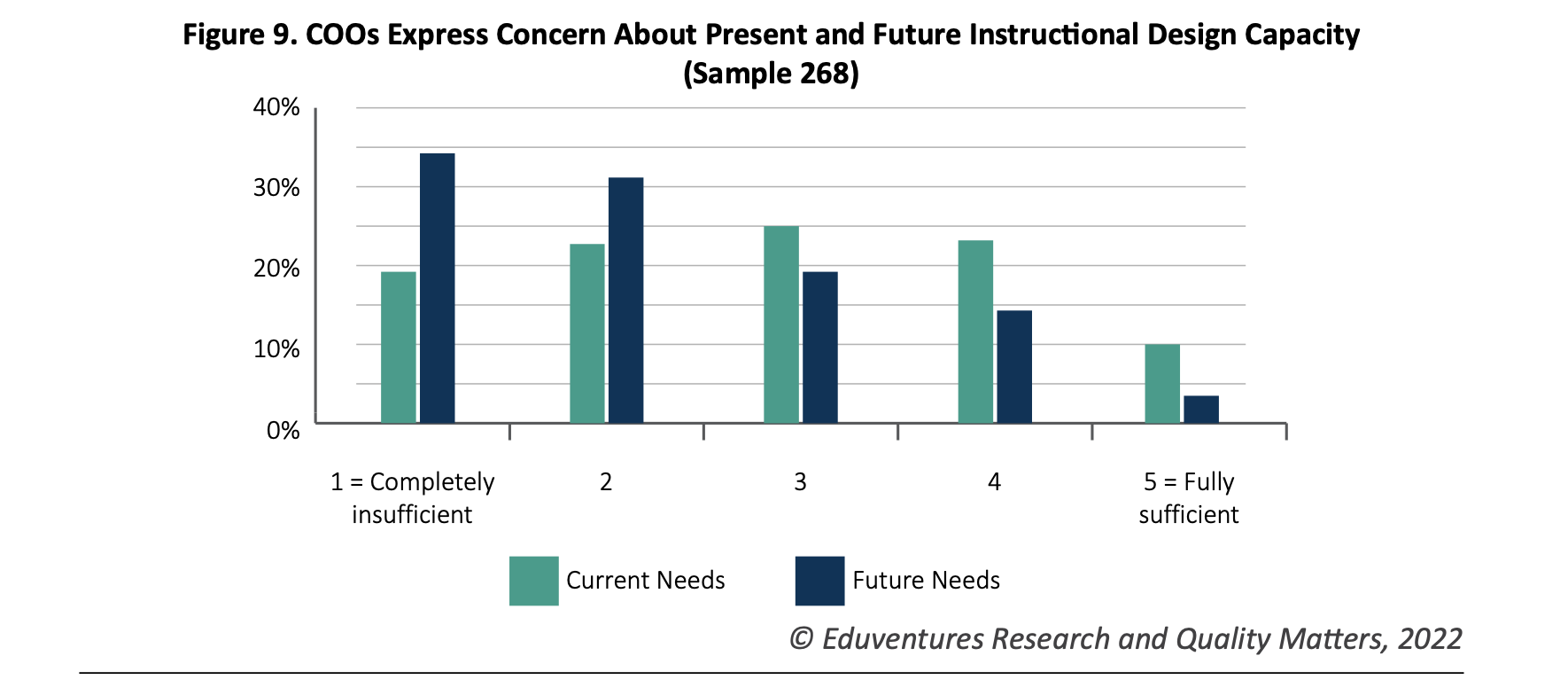You have /5 articles left.
Sign up for a free account or log in.
I'm starting to dig into the newly released CHLOE 7: Tracking Online Learning From Mainstream Acceptance to Universal Adoption.
The findings that are jumping out involve staffing for instructional designers. The key quote from the report:
Only 10% of online leaders said that ID capacity as of Fall 2021 was "fully sufficient" for present needs, and only 3% judged it to meet anticipated needs (Figure 9). Given COOs' projection of significant further growth in online enrollment, insufficient instructional design staffing may be one of online learning's most serious long-term vulnerabilities.

What might it mean for only 3 percent of online leaders think that instructional designer capacity is "fully sufficient" to meet anticipated needs? Five thoughts:
1 - Current IDs must be incredibly busy.
The findings from CHLOE 7 indicate a significant mismatch between institutional demand for instructional design services and the available supply. Moreover, this imbalance will likely only get worse.
I can only imagine how this looks to instructional design colleagues across our higher ed ecosystem. Those folks must be incredibly busy.
Should we be worried about ID burnout? Instructional designers were essential university workers in keeping in enabling academic resilience during the height of the pandemic. The question is, have these colleagues ever had a chance to catch their breath?
2 - We will see many more university remote and hybrid ID roles.
One result of the growing demand for instructional designers is likely to be a re-ordering of the ID labor market. Schools will likely need to offer flexible and remote work options to get the best ID talent.
In many ways, the work of an instructional designer is well suited for hybrid and remote work. As teaching and learning are increasingly digitally mediated, course and program development can also work well online.
If a professor is comfortable teaching online, collaborating with an instructional designer over digital platforms will also feel comfortable.
The challenge will be how to integrate remote IDs into campus culture. I'm sure an instructional designer could backward design an optimal remote working environment, but they are too busy working on courses and programs to do so.
3 - Faculty and instructional designers are increasingly collaborating on residential courses.
As CHLOE 7 indicates, the pace of online learning program development has accelerated coming out of Covid. IDs are essential for online learning. As it turns out, IDs are also key team members in the design of larger enrollment (foundational, introductory, and gateway) courses.
If you want to make a larger lecture class feel like a seminar, then you should work with an instructional designer. If you are determined to shift from relying on high-stakes summative assessments to formative assessments that encourage learning, then you want to work with an instructional designer.
If your course is to be accessible to all learners, then you want to work with an instructional designer. If you anticipate your students needing to move between in-person and online participation in your course, then you want to work with an instructional designer.
The internal competition for ID time will only grow more acute as we look to inject their knowledge, skills, and talents into both our online and residential offerings.
4 - White glove ID services will evolve to stress coaching and consulting.
There are a couple of models of how instructional designers work with faculty in the online learning world. One model is white glove, - meaning that the faculty provide the IDs materials (decks, documents, syllabi, etc.) and have lots of conversations. The instructional designers then build the courses in the learning management system (LMS).
The other model is a coaching and training system, where IDs create examples and offer one-on-one consulting and assistance, but the faculty are expected to create and edit their courses.
With a shortage of IDs across our institutions, it is hard to imagine that a boutique ID setup is either scalable or sustainable.
5 - Treating instructional design professionals as valued educators will be increasingly crucial for recruitment and retention.
Instructional designers occupy this weird institutional place. They are staff, but they are educators. IDs are essential to the educational enterprise, yet academic leadership often does not understand their roles.
Online education has always been a team sport, with instructors working closely with instructional designers. The future of residential education is hybrid, meaning that instructional designers will be indispensable to our institutions' core teaching and learning operations.
And yet, IDs often lack their faculty colleagues' recognition, status, and visible career paths. For instructional designers, there is no opportunity for tenure, academic freedom, or to recharge with sabbaticals.
Forward-thinking universities may find that they need to start offering star non-faculty educators the same recognition and incentives that have long been necessary to recruit and retain star tenure-line faculty.
Academic leaders who wisely decide to invest time reading CHLOE 7 report may be persuaded that they need to think about campus instructional design professionals through an institutional and strategic lens.




